Ware sicher verpackt und schnell verschickt. Alles bestens!
Se översättningFenicisk Terrakotta Ex-Voto eller Idol som föreställer en Triton. 6:e-4:e århundradet f.Kr. 32 cm H. Gammal proveniens.
Nr 90345141
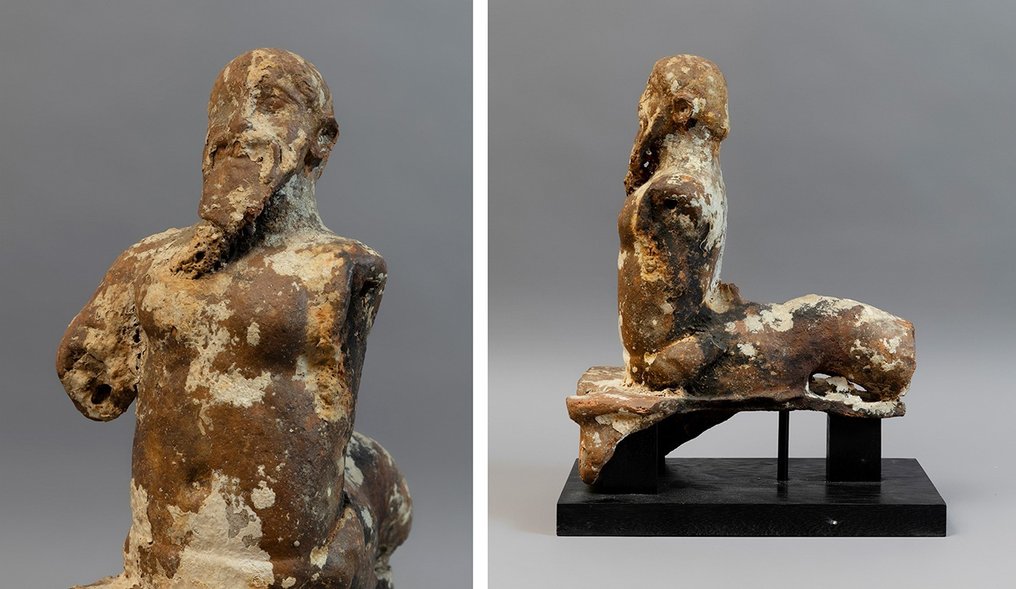
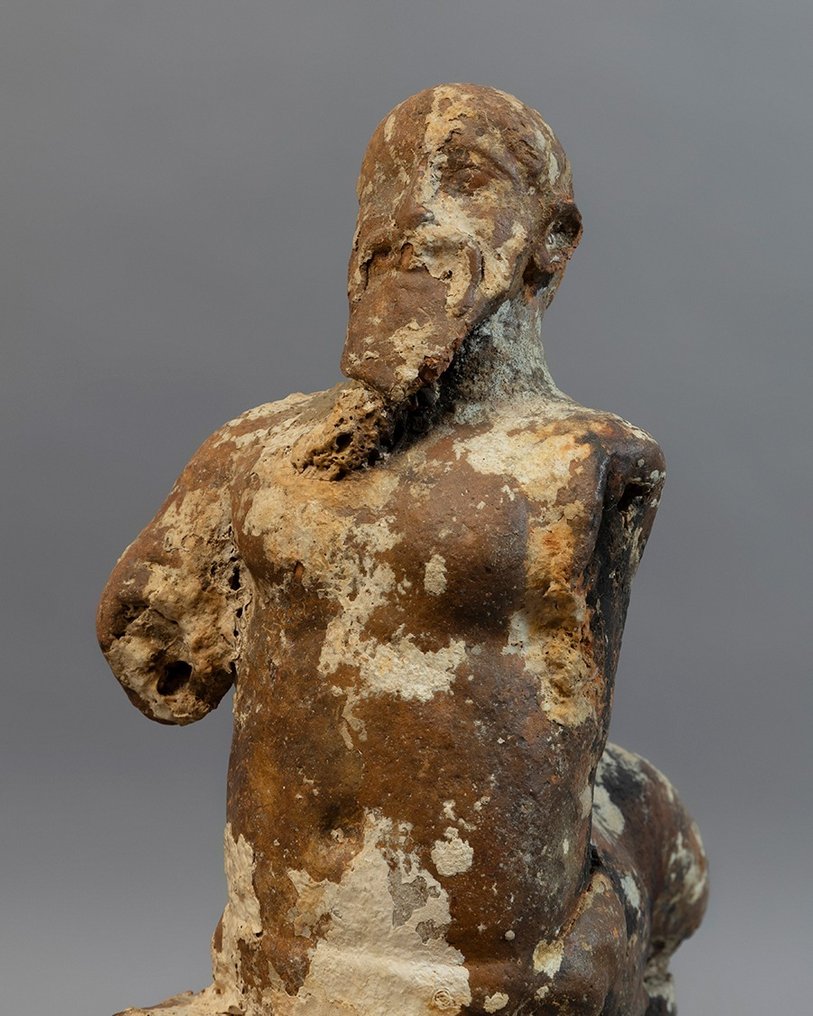
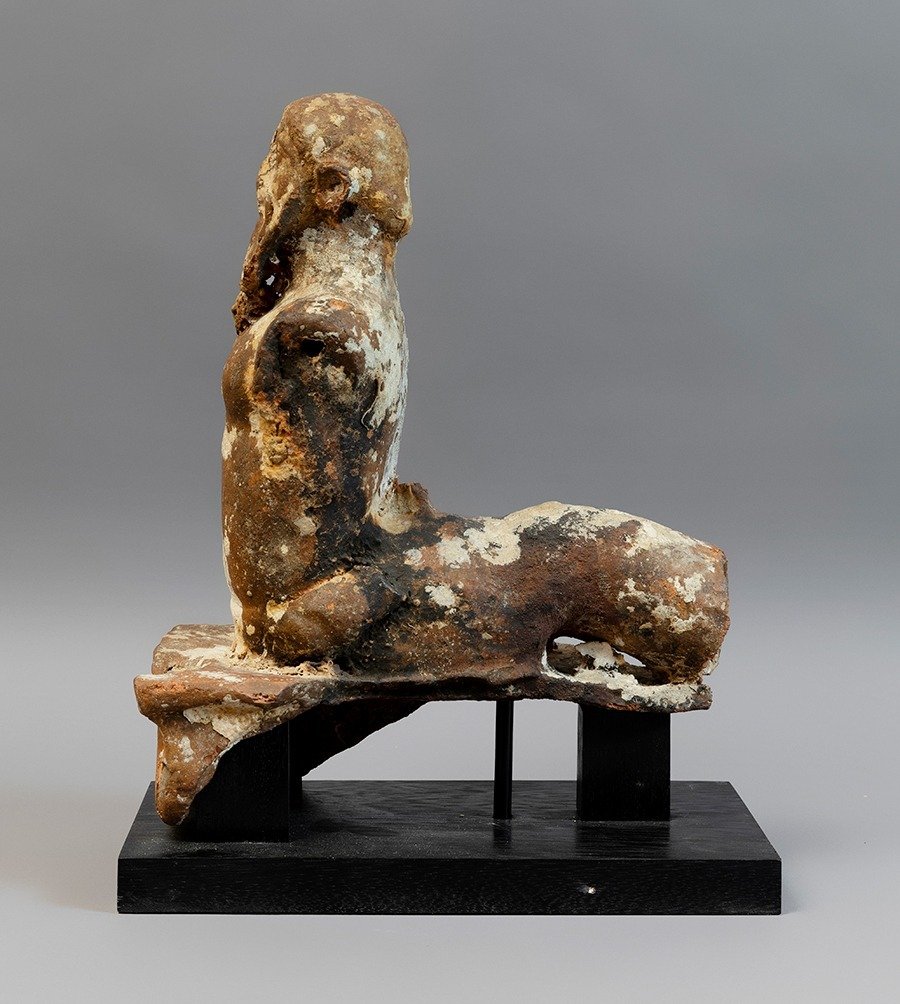
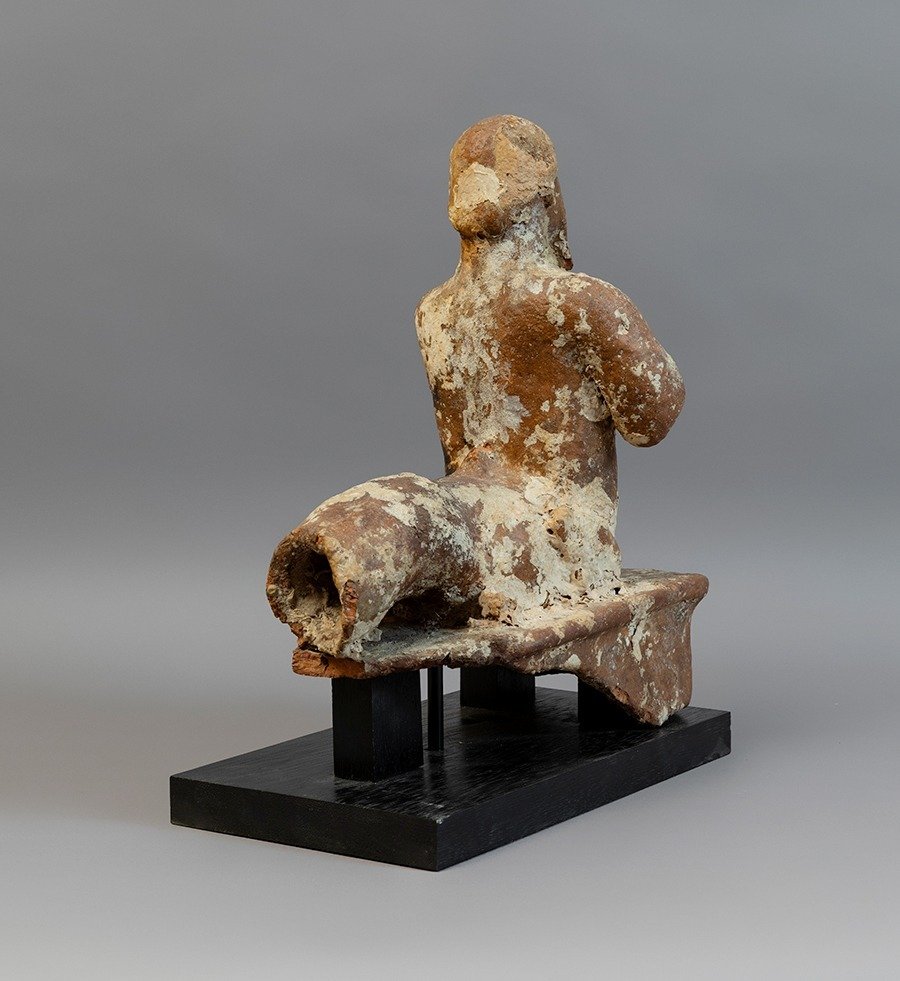
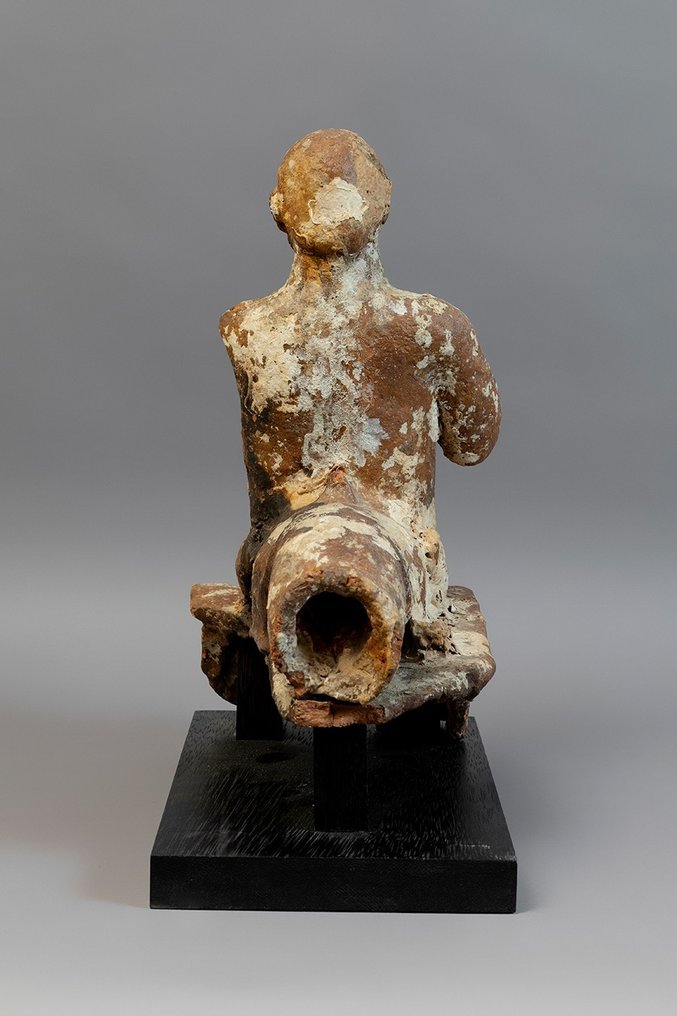
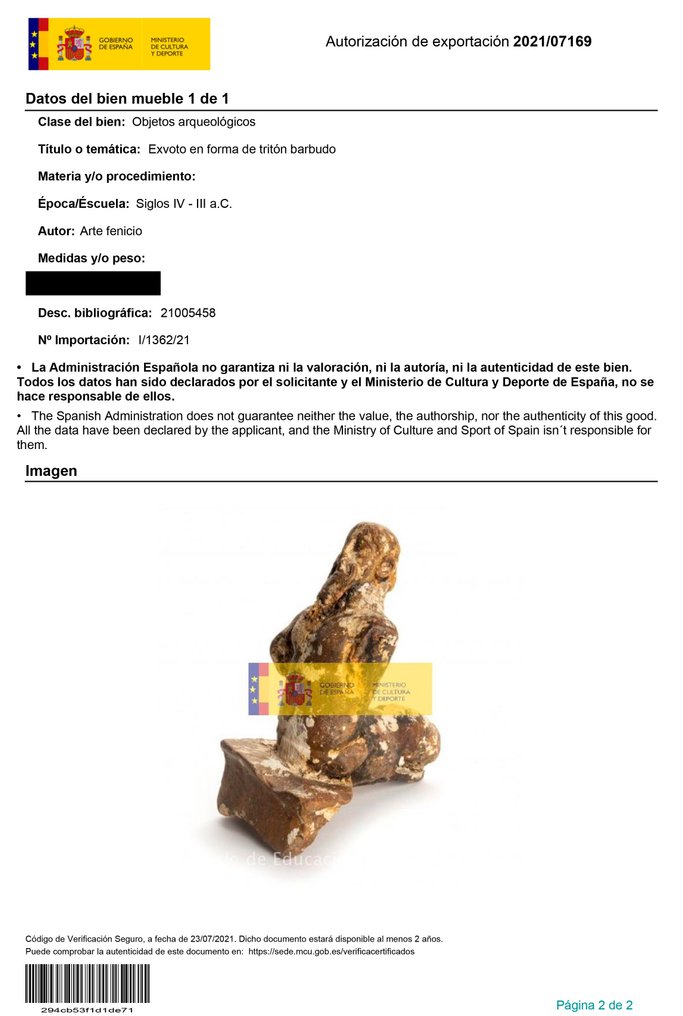
Important figure of an Ex-Voto or Idol depicting a Triton.
Phoenician, c. 6th - 4th century B.C.
32 cm H and 27 cm L. (without stand) 36 cm H with stand.
- STAND DISPLAY INCLUDED -
PROVENANCE: Maurice Druon Collection, Paris 1918 - 2009. Druon was a French writer and academic, Minister of Culture of France between 1973 and 1974.
CONDITION: Good state, see photos, unrestored.
DESCRIPCTION:
It is representing a Hybrid creature, the upper half being a man's body and lower half is a fish's body, specifically the tail.
It is presented on a base made in the form of an altar. The human torso is naked, with fine features such as the chest and the navel. The face has a serene expression with large almond shaped eyes highlighted by eyelids that are marked with a thick line, this being a Phoenician interpretation that is of clear Greek Archaïc inspiration.
At the height of the chin, there is a false beard, reminiscent of that used by the Egyptian pharaohs as a sign of power. The hair is worked in a smooth way, delimited in all its contour by a line of geometric design that frames the form of the man's head, this in turn links with the classic Greek tradition. In this way we can see how it is a piece that eclectically combines influences from styles such as Greek or Egyptian, the result of the Phoenicians' contacts with these cultures.
With respect to its iconography, it could be Yam, the god of the sea in the Canaanite pantheon. Yam is a deity of the sea and his palace is in the abyss associated with the depths. He represents the primordial chaos, the power of the sea, uncontainable and furious; he is seen as the god of dominant storms and the disasters they cause, and he was an important deity for the maritime Phoenicians.
This figure belongs to a group of Phoenician terracottas that remained 2,500 years under the sea until the 1960s when a fortuitous discovery made it possible to find all the pieces. One of the hypotheses that are being considered is that the Phoenicians, faced with the siege that the city suffered by Alexander the Great, loaded their ships with these pieces in order to escape from the city with their most precious goods. However, a storm must have surprised them a few kilometres from the coast, causing the ship to sink and the terracotta boats it contained to sink.
The sea god Triton, of Greek origin, is depicted on this Phoenician votive offering with a stylised face framed by a beard that gives him an aristocratic bearing. The muscular torso curves at the level of the hips, growing to the back with a long tail. He probably originally could have been blowing a conch shell. It follows Greek precepts in terms of representation, with the torso of a man and the lower part of a fish. Legend has it that Triton lived with his parents, Poseidon and Amphitrite, in a golden palace at the bottom of the sea. He is often depicted with a conch shell that he blows like a trumpet. The Phoenician culture, and later the Romans, inherited this figure and reinterpreted its symbolism. Here, adopting the role of an ex-vota, he gives good fortune to sailors.
Notes:
The seller guarantees that he acquired this piece according to all national and international laws related to the ownership of cultural property. Provenance statement seen by Catawiki.
The piece includes authenticity certificate.
The piece includes Spanish Export License.
THE MINISTRY OF CULTURE FROM SPAIN ASKS ALL SELLERS FOR INVOICES OR OTHER DOCUMENTATION ABLE TO PROVE THE LEGALITY OF EACH ITEM BEFORE PROVIDING AN IMPORT OR EXPORT LICENSE.
Säljarens berättelse
Important figure of an Ex-Voto or Idol depicting a Triton.
Phoenician, c. 6th - 4th century B.C.
32 cm H and 27 cm L. (without stand) 36 cm H with stand.
- STAND DISPLAY INCLUDED -
PROVENANCE: Maurice Druon Collection, Paris 1918 - 2009. Druon was a French writer and academic, Minister of Culture of France between 1973 and 1974.
CONDITION: Good state, see photos, unrestored.
DESCRIPCTION:
It is representing a Hybrid creature, the upper half being a man's body and lower half is a fish's body, specifically the tail.
It is presented on a base made in the form of an altar. The human torso is naked, with fine features such as the chest and the navel. The face has a serene expression with large almond shaped eyes highlighted by eyelids that are marked with a thick line, this being a Phoenician interpretation that is of clear Greek Archaïc inspiration.
At the height of the chin, there is a false beard, reminiscent of that used by the Egyptian pharaohs as a sign of power. The hair is worked in a smooth way, delimited in all its contour by a line of geometric design that frames the form of the man's head, this in turn links with the classic Greek tradition. In this way we can see how it is a piece that eclectically combines influences from styles such as Greek or Egyptian, the result of the Phoenicians' contacts with these cultures.
With respect to its iconography, it could be Yam, the god of the sea in the Canaanite pantheon. Yam is a deity of the sea and his palace is in the abyss associated with the depths. He represents the primordial chaos, the power of the sea, uncontainable and furious; he is seen as the god of dominant storms and the disasters they cause, and he was an important deity for the maritime Phoenicians.
This figure belongs to a group of Phoenician terracottas that remained 2,500 years under the sea until the 1960s when a fortuitous discovery made it possible to find all the pieces. One of the hypotheses that are being considered is that the Phoenicians, faced with the siege that the city suffered by Alexander the Great, loaded their ships with these pieces in order to escape from the city with their most precious goods. However, a storm must have surprised them a few kilometres from the coast, causing the ship to sink and the terracotta boats it contained to sink.
The sea god Triton, of Greek origin, is depicted on this Phoenician votive offering with a stylised face framed by a beard that gives him an aristocratic bearing. The muscular torso curves at the level of the hips, growing to the back with a long tail. He probably originally could have been blowing a conch shell. It follows Greek precepts in terms of representation, with the torso of a man and the lower part of a fish. Legend has it that Triton lived with his parents, Poseidon and Amphitrite, in a golden palace at the bottom of the sea. He is often depicted with a conch shell that he blows like a trumpet. The Phoenician culture, and later the Romans, inherited this figure and reinterpreted its symbolism. Here, adopting the role of an ex-vota, he gives good fortune to sailors.
Notes:
The seller guarantees that he acquired this piece according to all national and international laws related to the ownership of cultural property. Provenance statement seen by Catawiki.
The piece includes authenticity certificate.
The piece includes Spanish Export License.
THE MINISTRY OF CULTURE FROM SPAIN ASKS ALL SELLERS FOR INVOICES OR OTHER DOCUMENTATION ABLE TO PROVE THE LEGALITY OF EACH ITEM BEFORE PROVIDING AN IMPORT OR EXPORT LICENSE.
Säljarens berättelse
- 818
- 9
- 2
Muy buenos siempre … Bagot siempre es de confianza.
Se översättningI am really pleased with my purchase it's really lovely. It's beauty and quality exceed my expectations. The object was well wrapped and packed.
Se översättningGisteren niet ontvangen normal hebben ze mijn handtekening nodig doch lag bij de gebeuren ,eind goeg al goed😃😊
Se översättningbellissima ciotola etrusca top 💯💯💯💯💯💯💯💯 grazie :-)
Se översättningTodo bien
Se översättningMuy bien todo. Gracias
Se översättningPerfect
Se översättningThank you, everything was perfect!
Se översättningpiezas muy interesantes. Todo muy correcto, como siempre.
Se översättningestoy muy agradecida por como han tenido tanto tacto y cuidado en enviar la figura protegida, su certificado de autenticidad es muy profesional, al igual que su atención y trato con el cliente
Se översättningEl vendedor cumple lo prometido, el objeto es de alta calidad, entonces estoy muy satisfecho con mi compra, muchas gracias.
Se översättningPerfect!
Se översättningI just love the mood in this picture! I’m not even a cat-person. Seller was nice and made sure to ship it on a certain date, since i was traveling. I’m very happy with my purchase 🐱🤩 thank you!
Se översättningAll good, thank you !
Se översättningAll good, thank you !
Se översättningOne item was missing, one was damaged. Photos sent as requested. After that, no more communication even when asked. Too bad!
Se översättningmerci, jolie bijou.
Se översättningIk heb het goed en snel ontvangen. Het ziet er goed uit. Ben er blij mee.
Se översättningGreat seller!!
Se översättningBagot siempre rápido y fiable, muchas gracias
Se översättninggreat scarab! very fast shipping! thank you very much!
Se översättningTodo bien. Vendedor recomendado.
Se översättningAbsolut vertrauenswürdiger Händler ! Und: ein ganz zauberhaftes Stück !
Se översättningOttimo imballo particolare come da foto
Se översättning- 818
- 9
- 2
Ware sicher verpackt und schnell verschickt. Alles bestens!
Se översättningAnsvarsfriskrivning
Säljaren garanterar och kan bevisa att objektet införskaffats på lagligt sätt. Säljaren har informerats av Catawiki att de måste lämna den dokumentation som är obligatorisk enligt lagar och regler i det land de är bosatta. Säljaren garanterar och har rätt att sälja/exportera detta objekt. Säljaren tillhandahåller all information om härkomst som är känd om objektet till köparen. Säljaren säkerställer att alla nödvändiga tillstånd är/kommer att bli ordnade. Säljaren informerar köparen omedelbart om eventuella förseningar gällande att anskaffa sådana tillstånd.
Säljaren garanterar och kan bevisa att objektet införskaffats på lagligt sätt. Säljaren har informerats av Catawiki att de måste lämna den dokumentation som är obligatorisk enligt lagar och regler i det land de är bosatta. Säljaren garanterar och har rätt att sälja/exportera detta objekt. Säljaren tillhandahåller all information om härkomst som är känd om objektet till köparen. Säljaren säkerställer att alla nödvändiga tillstånd är/kommer att bli ordnade. Säljaren informerar köparen omedelbart om eventuella förseningar gällande att anskaffa sådana tillstånd.